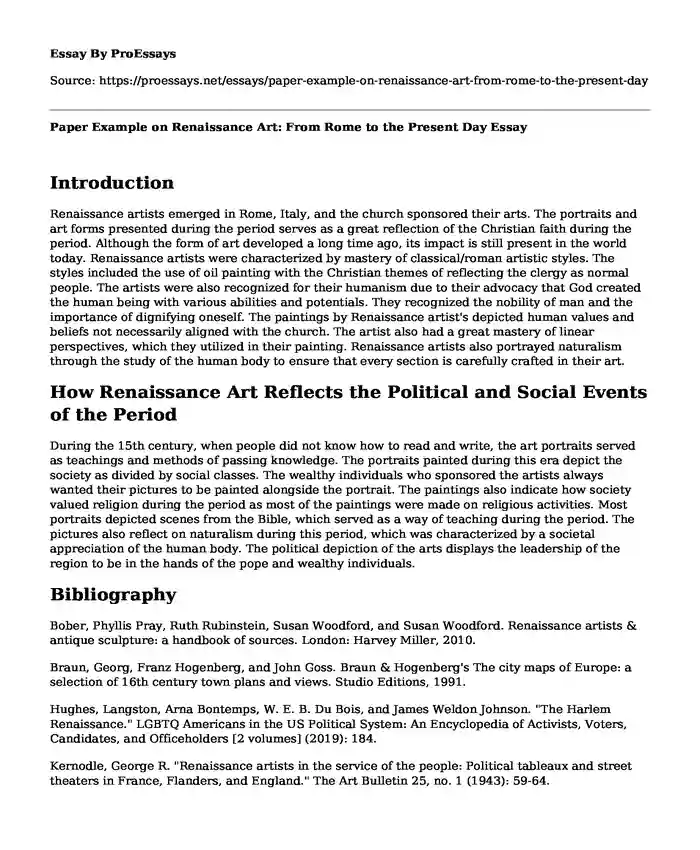Introduction
Renaissance artists emerged in Rome, Italy, and the church sponsored their arts. The portraits and art forms presented during the period serves as a great reflection of the Christian faith during the period. Although the form of art developed a long time ago, its impact is still present in the world today. Renaissance artists were characterized by mastery of classical/roman artistic styles. The styles included the use of oil painting with the Christian themes of reflecting the clergy as normal people. The artists were also recognized for their humanism due to their advocacy that God created the human being with various abilities and potentials. They recognized the nobility of man and the importance of dignifying oneself. The paintings by Renaissance artist's depicted human values and beliefs not necessarily aligned with the church. The artist also had a great mastery of linear perspectives, which they utilized in their painting. Renaissance artists also portrayed naturalism through the study of the human body to ensure that every section is carefully crafted in their art.
How Renaissance Art Reflects the Political and Social Events of the Period
During the 15th century, when people did not know how to read and write, the art portraits served as teachings and methods of passing knowledge. The portraits painted during this era depict the society as divided by social classes. The wealthy individuals who sponsored the artists always wanted their pictures to be painted alongside the portrait. The paintings also indicate how society valued religion during the period as most of the paintings were made on religious activities. Most portraits depicted scenes from the Bible, which served as a way of teaching during the period. The pictures also reflect on naturalism during this period, which was characterized by a societal appreciation of the human body. The political depiction of the arts displays the leadership of the region to be in the hands of the pope and wealthy individuals.
Bibliography
Bober, Phyllis Pray, Ruth Rubinstein, Susan Woodford, and Susan Woodford. Renaissance artists & antique sculpture: a handbook of sources. London: Harvey Miller, 2010.
Braun, Georg, Franz Hogenberg, and John Goss. Braun & Hogenberg's The city maps of Europe: a selection of 16th century town plans and views. Studio Editions, 1991.
Hughes, Langston, Arna Bontemps, W. E. B. Du Bois, and James Weldon Johnson. "The Harlem Renaissance." LGBTQ Americans in the US Political System: An Encyclopedia of Activists, Voters, Candidates, and Officeholders [2 volumes] (2019): 184.
Kernodle, George R. "Renaissance artists in the service of the people: Political tableaux and street theaters in France, Flanders, and England." The Art Bulletin 25, no. 1 (1943): 59-64.
Seymour, Charles. Michelangelo, the Sistine Chapel ceiling: illustrations, introductory essays, backgrounds, and sources, critical essays. Norton, 1972.
Cite this page
Paper Example on Renaissance Art: From Rome to the Present Day. (2023, Sep 23). Retrieved from https://proessays.net/essays/paper-example-on-renaissance-art-from-rome-to-the-present-day
If you are the original author of this essay and no longer wish to have it published on the ProEssays website, please click below to request its removal:
- Annunciation by Leonardo da Vinci Essay
- Term Paper on US Industrial Revolution: Establishing US Superiority in Late 1800s
- Essay Example on John Smith Patterson: Presenting South Carolina's Wish to Secede
- Religion's Impact: From Abolition of Slavery to Abortion Debate - Research Paper
- Essay Sample on Michael Jackson: The King of Pop, Born in Gary, India, 1958
- Fake News: The Threat to Democracy and Free Press - Essay Sample
- Movie Analysis Essay on Stress, A portrait of a killer







